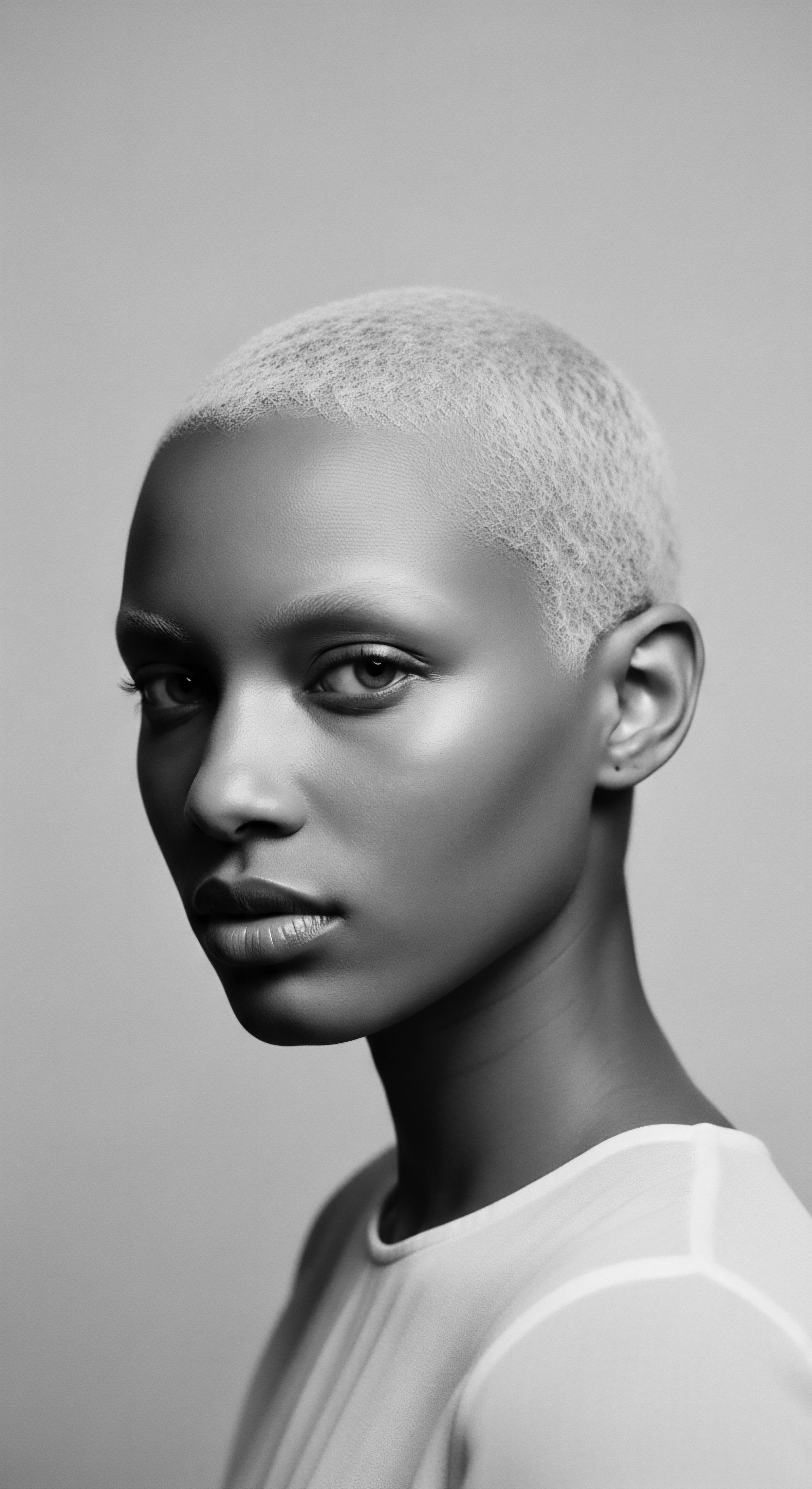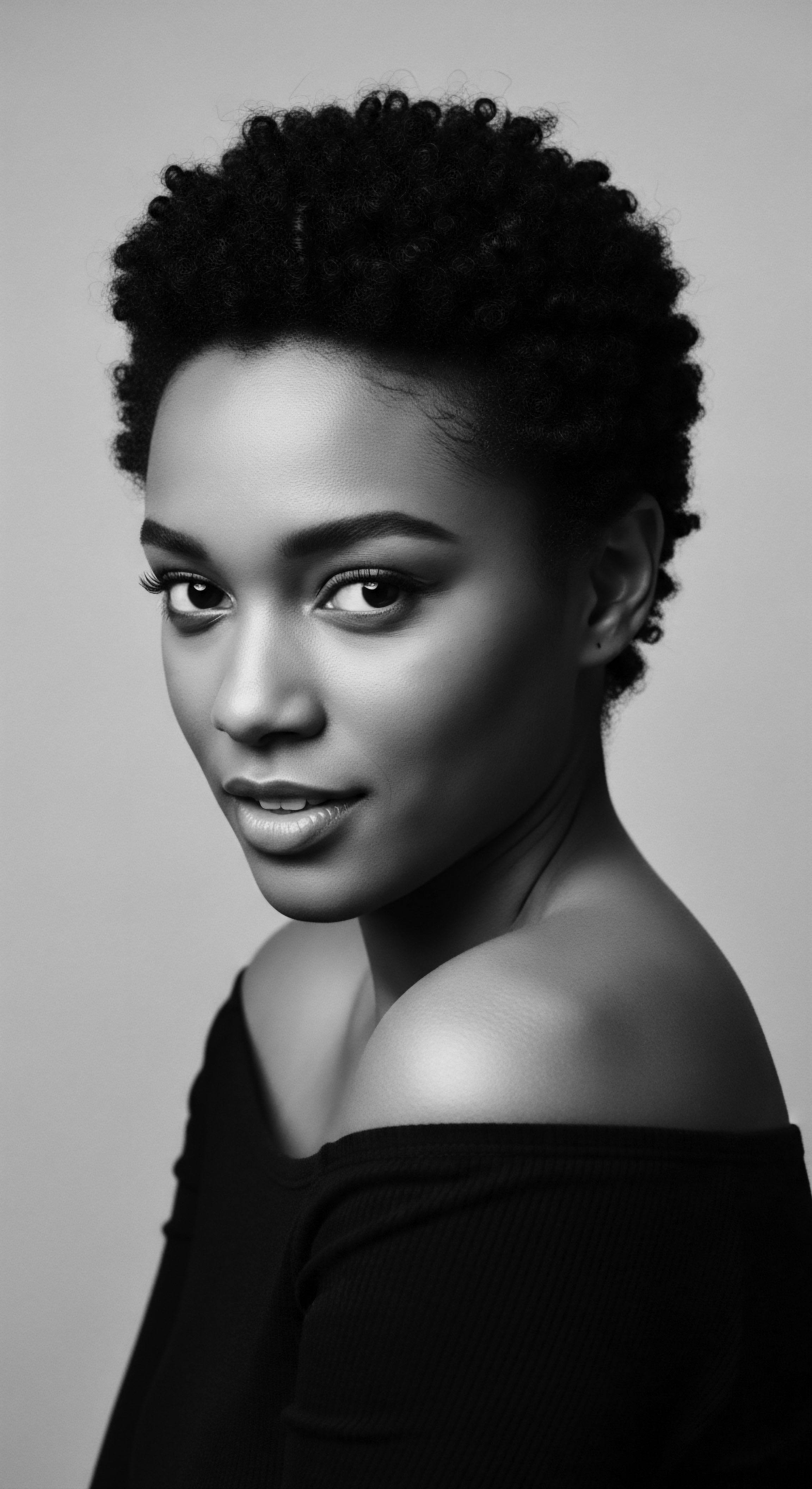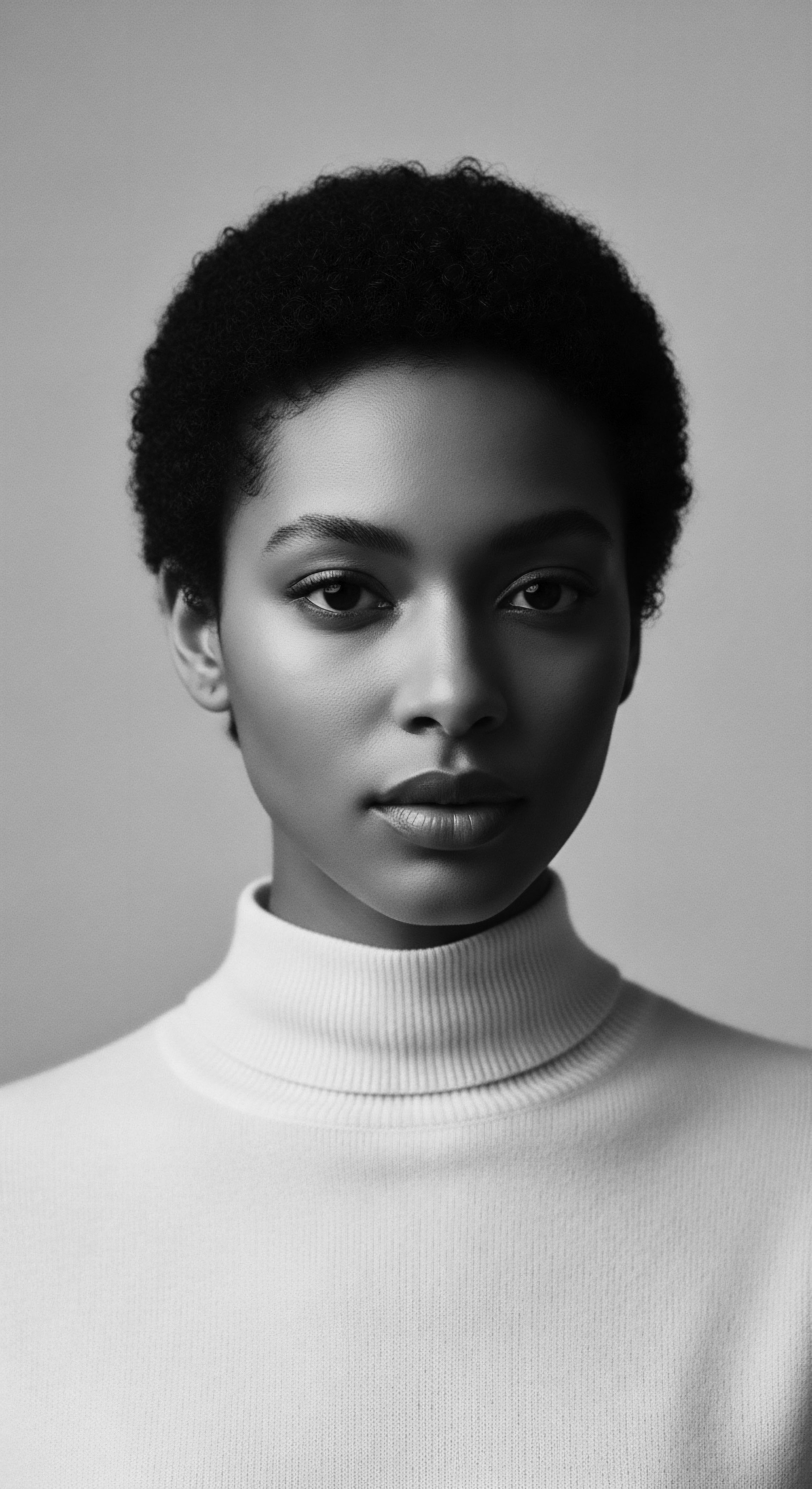
Roots
There exists a profound silence, often, around the historical whispers that shaped textured hair care. For those of us with coils, kinks, and waves, the journey into hydration has always been an elemental quest, a deep knowing passed through hands and hearths rather than printed tomes. This is a story etched not in the sterile language of laboratories, but in the enduring spirit of ancestors who understood the very breath of a strand, its inherent thirst, and how the earth offered its remedies. To speak of textured hair dryness is to speak of heritage itself, of a wisdom cultivated over centuries, a resilience echoing through generations.
The inherent architecture of textured hair, characterized by its elliptical shape and the raised cuticle scales, naturally presents a greater challenge for the distribution of sebum, the scalp’s natural oil, down the hair shaft. This structural reality makes it inherently prone to dryness compared to straight hair. Yet, this is not a deficit; rather, it is a unique design that invited ingenious solutions from those who wore it. Across diverse Black and mixed-race cultures, a deep knowledge blossomed concerning plants and their capacity to sustain the hair’s vitality.
This understanding formed the bedrock of ancestral hair practices, a legacy far older than any contemporary product label. It points to a time when care was directly tied to the land and its bounties, a symbiotic relationship between human need and botanical offering.

Understanding Ancestral Hair Hydration
Long before modern science rendered detailed diagrams of the hair shaft, our forebears intuitively grasped the need for profound moisture. They understood that external elements, from arid climates to the rigors of daily life, stripped textured hair of its suppleness. This recognition led to systematic practices aimed at replenishment. The term “hydration” then meant something visceral ❉ the feeling of softness, the absence of brittle ends, the way light caught a well-tended coil.
Traditional botanical practices weren’t about superficial shine; they centered on internal strength and moisture retention, addressing dryness from a holistic perspective of hair health. They were, in essence, the original formulators, their laboratories the village hearths, their ingredients the plants around them.

The Earliest Botanical Lexicon
Communities across Africa and the diaspora developed a precise, if unwritten, botanical lexicon for hair care. Certain plants became synonymous with specific benefits for textured hair. This deep connection to the natural world allowed for a sophisticated understanding of plant properties, distinguishing between those that sealed moisture, those that softened, and those that cleansed gently. This knowledge, passed down verbally and through demonstration, was an essential component of survival and cultural expression.
The ingredients weren’t arbitrary; they were selected for their proven efficacy, their availability, and their energetic resonance within the community’s broader wellness traditions. Think of it ❉ a communal recognition of what works, refined through countless applications.
Ancestral botanical practices offered profound moisture solutions, recognizing the inherent thirst of textured hair and addressing it with natural ingredients.
The botanical categories traditionally recognized for addressing hair dryness include, among others:
- Emollients ❉ These are substances that soften and smooth, often creating a protective layer to prevent water loss. Ancestral examples include various plant butters and fixed oils.
- Humectants ❉ These ingredients attract and hold water from the atmosphere into the hair. Gels and mucilaginous extracts from certain plants served this purpose.
- Fortifiers ❉ Botanicals used to strengthen the hair strand, reducing breakage that often accompanies dryness, helping hair retain its integrity and thus its moisture.
The practice of utilizing these elements was not merely functional; it was a deeply ingrained aspect of life, connecting individuals to their environment and to one another. The very act of preparing and applying these botanical remedies was a ritual, a moment of connection to a heritage of care that stretches back to time immemorial. The knowledge that a specific tree’s fruit or a particular root could bring vitality to hair became a shared treasure, a testament to human ingenuity and observation within the natural world.

Ritual
The application of botanical wisdom to textured hair dryness transcended simple routine; it became a living ritual, a set of practices imbued with cultural meaning and communal connection. From the rhythmic grinding of nuts to the gentle warming of oils, each step was a deliberate act of care, a conversation with the plant world that had sustained generations. These rituals were not static; they adapted across regions and communities, yet their core purpose remained steadfast ❉ to nourish, to protect, and to celebrate the unique beauty of textured hair.

Preparing Botanical Elixirs for Dry Hair
The making of hair elixirs was often a multi-step process, requiring patience and knowledge of the plant’s properties. For instance, in West Africa, women have for centuries harvested the nuts of the shea tree, then dried, crushed, and kneaded them to extract the butter. This laborious, communal process yields a powerful emollient known for its deep moisturizing properties, a balm for both skin and hair. The tactile engagement with the raw ingredients, the transformation from plant matter to nourishing balm, brought a sacred dimension to the practice.
It was a tangible link to the land and to the hands that had done this work for countless generations. The traditional preparation of remedies, such as the churning of shea butter, was often a collective endeavor, reinforcing community bonds.
Similarly, in the Caribbean, the careful extraction of oils like Jamaican black castor oil, traditionally involving roasting and boiling castor beans, produced a thick, nutrient-rich oil valued for sealing moisture and promoting hair health. These preparations were not just about the final product; they were about the continuity of ancestral techniques, the embodied knowledge passed from elder to youth, reinforcing a shared heritage of self-care and community well-being. This direct engagement with the plant world ensured purity and potency, a stark contrast to many industrial processes of today.

How Did Botanical Agents Fortify Protective Styles?
Textured hair’s propensity for dryness often led to the creation of protective styles, which minimize manipulation and exposure to the elements, thereby retaining moisture. Botanical agents played a crucial supporting role in these styles. Before braiding, twisting, or coiling the hair, it was customary to saturate the strands with nourishing plant oils and butters. This practice coated the hair, forming a barrier that sealed in hydration and mitigated moisture loss over extended periods.
For instance, the use of unrefined cocoa butter, sometimes mixed with shea, provided a substantial layer of moisture. These practices allowed styles to last longer while simultaneously providing ongoing conditioning. The oils helped to keep the hair pliable within the protective style, reducing breakage when the style was eventually taken down. The intentionality behind these applications speaks volumes about the detailed understanding of hair biology, long before the term “hair biology” existed.
The efficacy of these historical approaches is evident in their enduring presence and scientific validation. For example, modern research confirms that Shea Butter possesses a high content of fatty acids, including oleic, stearic, palmitic, and linoleic acids, along with vitamins A and E, which provide profound moisturizing and protective benefits. This scientific understanding affirms what generations of African women knew through observation and inherited wisdom ❉ that shea butter is a powerful ally against dryness. The practices were not random acts; they were empirically sound, honed over time by direct experience and tangible results.
| Botanical Ingredient Shea Butter (Vitellaria paradoxa) |
| Traditional Use for Dryness Applied directly as a balm; incorporated into hair masks to seal moisture and protect from harsh environments. |
| Contemporary Perspective on Moisture Rich in fatty acids and vitamins (A, E, F); creates a protective barrier, reducing transepidermal water loss. |
| Botanical Ingredient Coconut Oil (Cocos nucifera) |
| Traditional Use for Dryness Used as a pre-shampoo treatment, leave-in conditioner, or a sealant, especially in Caribbean communities. |
| Contemporary Perspective on Moisture Penetrates the hair shaft deeply due to its lauric acid content; reduces protein loss and provides internal conditioning. |
| Botanical Ingredient Aloe Vera (Aloe barbadensis miller) |
| Traditional Use for Dryness Fresh gel applied to hair and scalp for soothing and hydration; infusions used as rinses. |
| Contemporary Perspective on Moisture Contains humectant properties, attracting and retaining water; provides anti-inflammatory benefits for the scalp. |
| Botanical Ingredient Marshmallow Root (Althaea officinalis) |
| Traditional Use for Dryness Boiled to create a mucilaginous liquid used for slip and detangling, aiding in moisture distribution. |
| Contemporary Perspective on Moisture Its polysaccharides create a film, acting as a humectant and providing slip, which helps manage coily hair without breakage. |
| Botanical Ingredient Jamaican Black Castor Oil (Ricinus communis) |
| Traditional Use for Dryness Thick oil massaged into scalp and ends to seal in moisture and promote hair growth. |
| Contemporary Perspective on Moisture High in ricinoleic acid, a fatty acid that helps lock in moisture and has properties that support scalp health. |
| Botanical Ingredient These botanical staples, deeply rooted in heritage, continue to offer effective solutions for textured hair hydration, bridging ancient wisdom with modern understanding. |
The meticulous preparation of plant-based remedies, such as shea butter, served as both a practical means of hydration and a meaningful communal tradition.
One compelling historical example resides within the hair care practices of the Miskito people of Honduras, who have for centuries relied on Batana Oil. This oil, extracted from the nuts of the American palm tree (Elaeis oleifera), is renowned for its capacity to restore vitality to hair and skin. It is exceptionally rich in fatty acids, particularly oleic and linoleic acids, which allows it to deeply penetrate and replenish moisture.
This indigenous knowledge, passed down through generations, highlights a profound ethnobotanical understanding of environmental resources for hair health. The consistent use of Batana oil by the Miskito people to address dryness and maintain the luster of their hair is not merely anecdotal; it is a living testament to a sophisticated system of botanical medicine and cosmetic application that precedes formalized scientific study.
The knowledge of these plants and their particular properties was not isolated to a single continent or community. As people of African descent navigated the transatlantic voyages, their botanical understanding adapted, incorporating new plant resources while maintaining core principles of care. This adaptability underscores the enduring wisdom embedded in these ancestral practices, demonstrating a profound reverence for the well-being of the hair, not as an isolated entity, but as a valued part of one’s entire being. The ingenuity of these traditions, born of necessity and deep observation, provides a powerful foundation for understanding textured hair health today.

Relay
The lineage of textured hair care, particularly in addressing its natural inclination towards dryness, is a relay race of wisdom. Each generation has taken the baton of ancestral knowledge, adding their own insights, adapting practices to new environments, and carrying forward the profound respect for the strand’s inherent spirit. This continuous transmission of botanical practices across the Black and mixed-race diaspora is a testament to cultural fortitude and the enduring power of community. It is here that the scientific rationale frequently aligns with long-held traditions, illuminating the deep intelligence embedded in heritage practices.

Ethnobotanical Knowledge Systems
Across Africa and its diaspora, complex ethnobotanical knowledge systems evolved, meticulously detailing the uses of plants for health, nourishment, and adornment. These systems were holistic, integrating spiritual beliefs, communal well-being, and practical applications. When it came to textured hair, specific plants were identified not just for their moisturizing properties, but for their synergy within a broader regimen designed to maintain scalp health and hair integrity. The collection, preparation, and application of these botanical ingredients formed a significant part of daily life, particularly for women, who often served as the primary custodians and transmitters of this specialized knowledge.
This knowledge was experiential, refined through centuries of observation and collective learning. It was not a static collection of facts, but a dynamic, living archive of botanical interactions and their benefits.
For instance, the application of various plant-derived humectants, substances that draw moisture from the air, was common. Ingredients like Aloe Vera, Flaxseed Gel, and Marshmallow Root, used in traditional concoctions, possess polysaccharides and mucilage that create a film on the hair, holding hydration. These botanical gels offer a gentle hold while ensuring moisture retention, a dual benefit recognized by ancestors who utilized them for both styling and conditioning. The modern understanding of humectants and emollients provides a scientific framework for the observed benefits of these ancient practices, validating the efficacy of inherited wisdom.
The transmission of ancestral botanical practices is a vibrant continuum, validating long-held traditions with contemporary scientific understanding.
The resilience of these traditional hair care practices is remarkable, particularly given the historical pressures faced by Black communities. During periods of enslavement and colonialism, efforts to strip away cultural identity often included suppressing traditional hair care methods in favor of Eurocentric standards. Yet, despite these challenges, ancestral knowledge persisted, passed down in secret, within families, and through informal networks. This continuity underscores the profound cultural significance of textured hair and the practices that sustained its health and beauty.
It speaks to an unyielding commitment to self-definition and the preservation of heritage in the face of adversity. Hair became a site of quiet resistance and enduring identity, and the botanicals its silent allies.

Intergenerational Transfer of Care Wisdom
The continuity of botanical hair care is perhaps most powerfully observed in the intergenerational transfer of wisdom. Grandmothers taught mothers, who in turn taught their daughters, often through hands-on lessons and shared rituals. This method of teaching ensured that the nuances of ingredient selection, preparation, and application were faithfully conveyed. It was a learning process rooted in observation and guided practice, a truly embodied form of education.
The tales woven during these sessions, the songs sung, and the community shared, created a deep emotional connection to the practices, making them more than just regimens; they became acts of love and cultural affirmation. This oral and practical tradition sustained comprehensive knowledge, ensuring the botanical practices remained dynamic and relevant across changing times and landscapes. It fostered a deep connection to shared history, where each stroke of a wide-tooth comb or application of a prepared oil was a link in a living chain.
Consider the ancestral principles that underpin effective care for dry textured hair, many of which find resonance in current best practices:
- Scalp Health Emphasis ❉ A healthy scalp provides the best environment for hair growth and natural oil production. Traditional practices often included scalp massages with oils and herbal rinses to stimulate circulation and maintain balance.
- Moisture Sealing ❉ Understanding that textured hair loses moisture quickly, ancestors consistently sealed in hydration with rich plant butters and oils after washing or moisturizing.
- Gentle Handling ❉ The fragility of textured hair meant careful manipulation, minimizing pulling and breakage, often aided by slippery botanical preparations for detangling.
A statistical insight from a qualitative study on Black women’s natural hair care communities highlights the challenge of navigating textured hair ❉ “Among the literature, the other most identified barrier among women deciding to ‘go natural’ was unfamiliarity and or frustration with their natural tresses. As explained by one author, many women of African descent have had their hair chemically straightened since they were young girls and never learned to care for their hair in its natural state.” This speaks to the painful disruption of intergenerational knowledge transmission that occurred due to societal pressures to conform to Eurocentric beauty standards. The natural hair movement of today, therefore, often represents a conscious reclamation of lost heritage, seeking to reconnect with and restore these ancestral botanical practices.
| Botanical Agent Moringa Oil (Moringa oleifera) |
| Traditional Preparation and Application Extracted from seeds, applied as a lightweight oil for scalp and hair nourishment, especially in regions of Africa where the tree is abundant. |
| Contemporary Scientific Insight on Moisture Rich in oleic acid and antioxidants, providing excellent moisturizing properties without heaviness; supports barrier function. |
| Botanical Agent Baobab Oil (Adansonia digitata) |
| Traditional Preparation and Application Pressed from baobab seeds; used as a conditioner and skin protectant, particularly in parts of Southern and West Africa. |
| Contemporary Scientific Insight on Moisture Contains fatty acids (oleic, linoleic, palmitic) and vitamins, aiding in moisture retention and improving elasticity. |
| Botanical Agent Fenugreek (Trigonella foenum-graecum) |
| Traditional Preparation and Application Seeds soaked to create a mucilaginous gel or ground into a powder for hair masks and rinses. |
| Contemporary Scientific Insight on Moisture Contains proteins and polysaccharides that coat the hair, offering conditioning, slippage, and moisture-attracting properties. |
| Botanical Agent Hibiscus (Hibiscus sabdariffa) |
| Traditional Preparation and Application Flowers and leaves steeped to make rinses or pastes for conditioning and stimulating hair health. |
| Contemporary Scientific Insight on Moisture Rich in amino acids and mucilage, providing a natural conditioning effect and contributing to hair softness and manageability. |
| Botanical Agent Rosemary (Rosmarinus officinalis) |
| Traditional Preparation and Application Infused in oils or water for scalp massages and rinses. |
| Contemporary Scientific Insight on Moisture Known for stimulating circulation to the scalp, which can support the overall health and vitality of hair. |
| Botanical Agent The enduring utility of these botanicals demonstrates a sophisticated ancestral understanding of plant chemistry and its application for textured hair well-being. |
The relay continues today, as modern natural hair care brands often look to these time-honored ingredients and methods as inspiration for their formulations. This connection reaffirms that the journey toward optimal textured hair health is not a novel concept, but a return to a heritage of profound botanical wisdom. It speaks to a cyclical process of rediscovery, where the echoes of the past guide paths to future well-being.

Reflection
The exploration of historical botanical practices addressing textured hair dryness reveals more than just ancient remedies; it reveals the very soul of a strand, a deep connection to heritage that persists through time. Textured hair, with its unique thirst and resilient spirit, has always been a canvas for cultural expression, a symbol of identity, and a repository of ancestral wisdom. The botanical practices crafted by our forebears were not simply functional solutions to a biological characteristic; they were profound acts of self-care, community building, and cultural preservation. These methods, born of intimate observation and lived experience, represent a science passed through generations, an ethnobotanical legacy that continues to resonate today.
The plants themselves—Shea, Coconut, Aloe, Mallow, Batana—are not merely ingredients; they are living testaments to human ingenuity and adaptability. Their properties, intuitively understood and skillfully applied, speak to a deep communion with the natural world. This historical journey affirms that the quest for hydrated, healthy textured hair is not a contemporary invention, but a continuum rooted in a rich and enduring past. It is a story of resilience, of knowledge whispered from one generation to the next, surviving displacement and societal pressures.
The care of textured hair, then, becomes a conscious act of honoring those who came before, a celebration of inherited beauty, and a powerful statement of self-acceptance. The vibrancy of today’s natural hair movement, often seeking out these traditional botanicals, acts as a beautiful affirmation of this living heritage. It is a reclamation, a returning to sources that have always known how to sustain the beauty and strength inherent in every coil and kink.

References
- Byrd, A. D. & Tharps, L. L. (2014). Hair Story ❉ Untangling the Roots of Black Hair in America. St. Martin’s Press.
- Gathers, R. C. & Lim, H. W. (2009). Central centrifugal cicatricial alopecia ❉ Past, present, and future. Journal of the American Academy of Dermatology, 60(4), 660-668.
- Khumalo, N. P. (2008). On the history of African hair care ❉ More treasures await discovery. Journal of Cosmetic Dermatology, 7(3), 231.
- Martinez, J. L. Maroyi, A. & Wagner, M. L. (Eds.). (2023). Ethnobotany ❉ From the Traditional to Ethnopharmacology. Routledge.
- Patton, T. O. (2014). Hey Girl, Am I More Than My Hair? The Communications Scholar, 6(1), 1-22.
- Smith, E. (2016). Black women’s natural hair care communities ❉ Social, political, and cultural implications. Smith ScholarWorks.
- Toups, L. (2025). Raw shea butter ❉ the origins of this product with many virtues. Toups and Co Organics.
- Voeks, R. A. (2013). African Ethnobotany in the Americas. University of Georgia Press.
- Warra, A. (2022). Ethnobotanical Advancements in Contemporary Skincare. IGI Global.
- Yap-McKay, M. (2013). Caribbean Hair & Beauty Secrets. NaturallyCurly.
